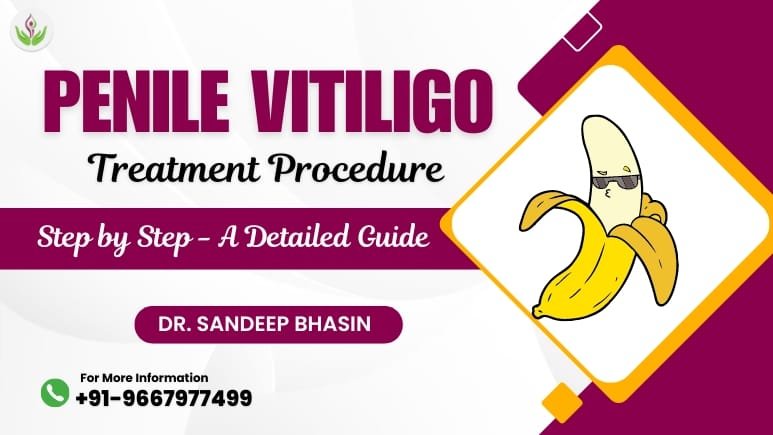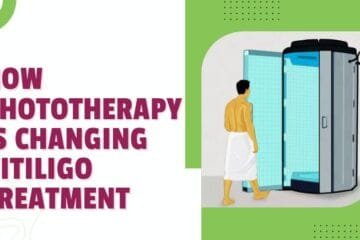Vitiligo is a skin condition characterized by the loss of pigmentation, leading to white patches on various parts of the body, including the genital area. Penile vitiligo can be particularly distressing due to its sensitive location and the psychological impact it may have. This guide aims to provide a detailed, easy-to-understand overview of the treatment options available for penile vitiligo.
As Dr. Sandeep Bhasin, I understand the concerns and emotional challenges associated with penile vitiligo. In this guide, I will walk you through the step-by-step vitiligo treatment procedures to help manage and treat this condition effectively.
Understanding Penile Vitiligo
Vitiligo occurs when melanocytes, the cells responsible for producing skin pigment, are destroyed. The exact cause of vitiligo is not fully understood, but it is believed to be an autoimmune disorder. It can affect any part of the body, including the penis, and the psychological impact of vitiligo in such a sensitive area can be significant.
Symptoms
- White patches on the skin
- Premature graying of hair
- Loss of color inside the mouth and nose
When these symptoms appear on the penis, they can cause additional emotional and psychological challenges due to the area’s visibility and personal significance.
Step-by-Step Guide to Treating Penile Vitiligo

Step 1: Consultation with a Dermatologist
- Seek Professional Advice: The first and most crucial step is to consult a dermatologist who has experience with vitiligo. They can provide a proper diagnosis and recommend the best treatment plan.
- Medical History and Examination: The dermatologist will take a detailed medical history and conduct a physical examination to confirm the diagnosis of vitiligo and rule out other conditions.
Step 2: Understanding Treatment Options
Topical Treatments:
- Corticosteroids: These are anti-inflammatory medications that can help restore pigment by suppressing the immune system locally.
- Calcineurin Inhibitors: These include tacrolimus and pimecrolimus, which are often used for sensitive areas like the genital region due to fewer side effects compared to steroids.
Phototherapy:
- Narrowband UVB Therapy: This involves exposing the skin to ultraviolet B (UVB) light, which can stimulate repigmentation. This treatment is often administered in a clinical setting.
- Excimer Laser: A targeted form of UVB therapy that can be more effective for small areas of vitiligo, such as those on the penis.
- Depigmentation: For extensive vitiligo, depigmentation of the remaining pigmented skin to match the white patches can be an option. This is usually considered when repigmentation treatments are ineffective.
Surgical Options:
- Skin Grafting: Involves transplanting pigmented skin from one part of the body to the affected area. This is a more invasive option and is typically considered when other treatments have failed.
- Melanocyte Transplantation: A newer technique where melanocytes are taken from normal skin and transplanted to the vitiligo-affected area.
Alternative Treatments:
- Herbal and Natural Remedies: Some people explore herbal treatments, though these should be approached with caution and under the guidance of a healthcare professional.
- Psychological Support: Counseling or therapy can be beneficial, as the emotional impact of vitiligo, especially in sensitive areas, can be significant.
Step 3: Developing a Treatment Plan
- Individualized Approach: Work with your dermatologist to develop a treatment plan tailored to your specific case. This may involve one or a combination of treatments.
- Considerations: The choice of treatment will depend on several factors, including the extent of the vitiligo, its location, your skin type, and your personal preferences.
Step 4: Treatment Implementation
- Adherence to Treatment: Follow the treatment plan as prescribed by your dermatologist. Consistency is key to seeing results.
- Monitoring Progress: Regular follow-up appointments with your dermatologist are essential to monitor progress and make any necessary adjustments to the treatment plan.
Step 5: Managing Expectations
- Realistic Goals: Understand that treatment for vitiligo can take time, and results vary from person to person. Some treatments may take several months to show noticeable improvement.
- Coping Mechanisms: Develop coping strategies to manage the psychological impact of penile vitiligo. Support groups and counseling can be helpful resources.
Tips for Managing Penile Vitiligo
- Sun Protection: Protecting the affected area from sun exposure is crucial. Use sunscreen with a high SPF to prevent further pigmentation loss.
- Healthy Lifestyle: Maintain a healthy diet and lifestyle, as overall health can impact skin condition. Incorporate foods rich in vitamins and minerals that promote skin health.
- Avoid Skin Trauma: Be gentle with the affected skin. Avoid activities that can cause friction or injury to the area.
Conclusion
Treating penile vitiligo requires a comprehensive, personalized approach. Consultation with a dermatologist is essential to developing an effective treatment plan. While vitiligo can be challenging to treat, various therapies, from topical treatments and phototherapy to surgical options, offer hope for repigmentation and improved quality of life. Managing expectations and seeking psychological support are also critical components of the treatment journey.
By following this step-by-step guide, individuals affected by penile vitiligo can better navigate their treatment options and work towards achieving the best possible outcomes.
FAQs
Penile vitiligo is a condition where white patches develop on the penis due to loss of skin pigment.
No, it is not contagious.
Treatments include topical creams, phototherapy, and surgical options.
Some treatments might cause mild discomfort or side effects, but they are generally well tolerated.
Treatment duration varies, often requiring several months to see results.
Yes, sun protection, a healthy diet, and stress management can support treatment.
Yes, many treatments require a dermatologist’s prescription.
Potential side effects include skin irritation, redness, and, rarely, scarring.
It can spread, but treatments aim to control and reduce its progression.










